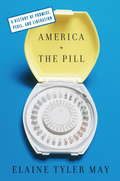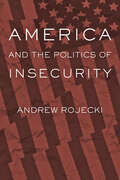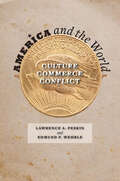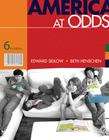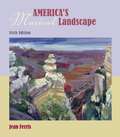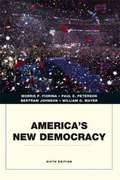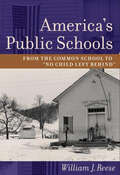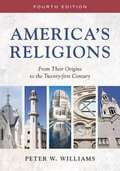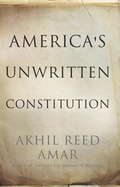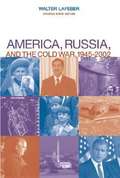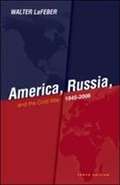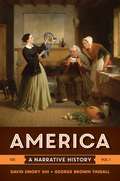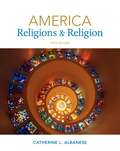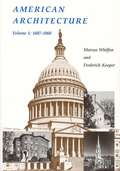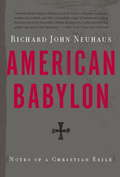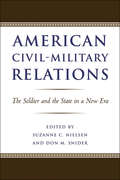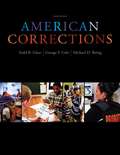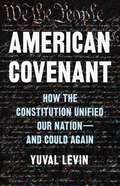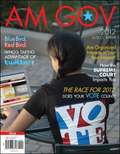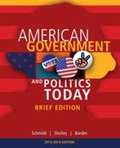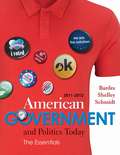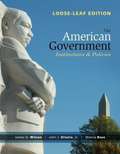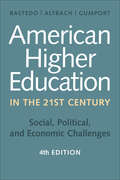- Table View
- List View
America and the Pill: A History of Promise, Peril, and Liberation
by Elaine Tyler MayIn 1960, the FDA approved the contraceptive commonly known as "the pill. ” Advocates, developers, and manufacturers believed that the convenient new drug would put an end to unwanted pregnancy, ensure happy marriages, and even eradicate poverty. But as renowned historian Elaine Tyler May reveals in America and the Pill, it was women who embraced it and created change. They used the pill to challenge the authority of doctors, pharmaceutical companies, and lawmakers. They demonstrated that the pill was about much more than family planning-it offered women control over their bodies and their lives. From little-known accounts of the early years to personal testimonies from young women today, May illuminates what the pill did and did not achieve during its half century on the market.
America and the Politics of Insecurity (Themes in Global Social Change)
by Andrew RojeckiAn innovative analysis of polarized politics post-9/11.In America and the Politics of Insecurity, Andrew Rojecki assesses the response of citizens and politicians to a series of crises that confronted the United States during the first decade of the twenty-first century. This period brought Americans face to face with extraordinarily difficult problems that were compounded by their origin in seemingly uncontrollable global forces. Rojecki establishes a theoretical framework for understanding how these new uncertainties contribute to increasingly polarized political discourse. Analyzing three domains of American insecurity—economic, environmental, and existential—Rojecki examines responses to the Great Recession by groups like the Tea Party and Occupy Wall Street; considers why the growing demand for fossil fuels makes people disregard global warming; and explores the desire for security measures that restrict personal freedom in the age of terrorism. Ultimately, he explains why the right has thus far held an edge over the left in the politics of insecurity.Rojecki concludes that in order to address these broad-scale political problems, we must reframe domestic issues as reactions to undiagnosed global conditions. Bringing the psychology of uncertainty together with contemporary case studies, this book is a sweeping diagnostic for—and antidote to—ineffective political discourse in a globalized world that imports bads as well as goods.
America and the World: Culture, Commerce, Conflict
by Edmund F. Wehrle Lawrence A. PeskinAlthough the twenty-first century may well be the age of globalization, this book demonstrates that America has actually been at the cutting edge of globalization since Columbus landed here five centuries ago.Lawrence A. Peskin and Edmund F. Wehrle explore America's evolving connections with Europe, Africa, and Asia in the three areas that historically have been indicators of global interaction: trade and industry, diplomacy and war, and the "soft" power of ideas and culture. Framed in four chronological eras that mark phases in the long history of globalization, this book considers the impact of international events and trends on the American story as well as the influence America has exerted on world developments. Peskin and Wehrle discuss how the nature of this influence—whether economic, cultural, or military—fluctuated in each period. They demonstrate how technology and disease enabled Europeans to subjugate the New World, how colonial American products transformed Europe and Africa, and how post-revolutionary American ideas helped foment revolutions in Europe and elsewhere. Next, the authors explore the American rise to global economic and military superpower—and how the accumulated might of the United States alienated many people around the world and bred dissent at home. During the civil rights movement, America borrowed much from the world as it sought to address the crippling "social questions" of the day at the same time that Americans—especially African Americans—offered a global model for change as the country strove to address social, racial, and gender inequality. Lively and accessible, America and the World draws on the most recent scholarship to provide a historical introduction to one of today's vital and misunderstood issues.
America at Odds (6th Edition)
by Beth Henschen Edward SidlowKnown for its provocative and engaging issues approach, AMERICA AT ODDS, 6e, now features a groundbreaking new magazine-style format that greatly enhances its visual appeal and readability while remaining affordable and convenient. This unique text provides a memorable and effective introduction to American government by focusing on the current and historical conflicts and controversies that define America as a nation. AMERICA AT ODDS combines compelling content, innovative design elements, and powerful teaching tools to help you discover and refine your opinions through active discussion and debate of essential topics in American government and politics.
America's Musical Landscape
by Jean FerrisThis textbook for music appreciation undergraduates surveys American music, relating it to the other arts and social and cultural contexts. Ferris (music history and appreciation, Arizona State U.) first explains the elements of music, then takes the reader on a chronological tour of American music, from North American Indian and folk music to contemporary mainstream concert music. Along the way, religious and secular music are discussed, as well as nineteenth century popular and concert music; country, folk, jazz, Latin music, and rock and roll; and musical theater, film music, and American opera. Listening charts are incorporated. This edition has been updated and reorganized, the amount of vernacular music has been expanded, and the recordings have been updated to match. Timelines are also new. No bibliography is provided. Annotation ©2006 Book News, Inc., Portland, OR (booknews.com)
America's New Democracy (6th Edition)
by Paul E. Peterson Morris P. Fiorina Bertram Johnson William G. MayerUpdated in a new 6th edition, America's New Democracy provides an engaging, analytical approach to American Government that stresses the importance of elections in contemporary American politics. Written in a strong narrative voice it provides a focused and stimulating treatment of politics in the United States. The book challenges the pessimistic view that government seldom listens to ordinary people by illustrating popular influence across the political system in defense of a central theme---that elections matter more in America's political system today than they have in the past or do in other democracies.
America's Public Schools: From the Common School to "No Child Left Behind" (The American Moment)
by William J. ReeseIn this update to his landmark publication, William J. Reese offers a comprehensive examination of the trends, theories, and practices that have shaped America’s public schools over the last two centuries. Reese approaches this subject along two main lines of inquiry—education as a means for reforming society and ongoing reform within the schools themselves. He explores the roots of contemporary educational policies and places modern battles over curriculum, pedagogy, race relations, and academic standards in historical perspective.A thoroughly revised epilogue outlines the significant challenges to public school education within the last five years. Reese analyzes the shortcomings of "No Child Left Behind" and the continued disjuncture between actual school performance and the expectations of government officials. He discusses the intrusive role of corporations, economic models for enticing better teacher performance, the continued impact of conservatism, and the growth of home schooling and charter schools. Informed by a breadth of historical scholarship and based squarely on primary sources, this volume remains the standard text for future teachers and scholars of education.
America's Religions: From Their Origins to the Twenty-first Century (3rd edition)
by Peter W. WilliamsIn this comprehensive survey, Williams offers concise descriptions of the background, beliefs, practices, and leaders of America's most influential and distinctive religious movements and denominations. Thoroughly revised and updated, this third edition of America's Religions incorporates the latest scholarship on religion and considers timely issues such as status of Muslims in the United States after September 11, 2001; the impact of religion on American politics, especially concerning the emergence of the Religious Right; and the intense battles fought within the Catholic Church and other denominations over the status of gay marriage and accusations of clergy members' sexual abuse. This edition also includes thirty-eight new illustrations of key persons in American religious history and notable places of worship.
America's Unwritten Constitution: The Precedents and Principles We Live By
by Akhil Reed AmarDespite its venerated place atop American law and politics, our written Constitution does not enumerate all of the rules and rights, principles and procedures that actually govern modern America. The document makes no explicit mention of cherished concepts like the separation of powers and the rule of law. On some issues, the plain meaning of the text misleads. For example, the text seems to say that the vice president presides over his own impeachment trial-but surely this cannot beright. As esteemed legal scholar Akhil Reed Amar explains inAmerica’s Unwritten Constitution, the solution to many constitutional puzzles lies not solely within the written document, but beyond it-in the vast trove of values, precedents, and practices that complement and complete the terse text. In this sequel toAmerica’s Constitution: A Biography, Amar takes readers on a tour of our nation’sunwrittenConstitution, showing how America’s foundational document cannot be understood in textual isolation. Proper constitutional interpretation depends on a variety of factors, such as the precedents set by early presidents and Congresses; common practices of modern American citizens; venerable judicial decisions; and particularly privileged sources of inspiration and guidance, including theFederalistpapers, William Blackstone’sCommentaries on the Laws of England, the Northwest Ordinance of 1787, Lincoln’s Gettysburg Address, and Martin Luther King, Jr. ’s "I Have a Dream” speech. These diverse supplements are indispensible instruments for making sense of the written Constitution. When used correctly, these extra-textual aids support and enrich the written document without supplanting it. An authoritative work by one of America’s preeminent legal scholars,America’s Unwritten Constitutionpresents a bold new vision of the American constitutional system, showing how the complementary relationship between the Constitution’s written and unwritten components is one of America’s greatest and most enduring strengths.
America, Russia, and the Cold War 1945-2002 (Updated Ninth Edition)
by Walter LafeberProfessor LaFeber explains the course of the Cold War as it moved from periods of intense crisis and confrontation to times of relative stability.
America, Russia, and the Cold War, 1945-2006 (Tenth Edition)
by Walter LafeberUsing extensive materials from both published and private sources, this concise text focuses on United States-Soviet diplomacy to explain the causes and consequences of the Cold War. It explores how the Cold War was shaped by domestic events in both the U. S. and the Soviet Union and presents a variety of other points of view on the conflict--Chinese, Latin American, European, and Vietnamese. The text includes both engaging anecdotes and quotes from primary sources to support key points and exemplify policies, and recent scholarship and materials from openings of the U. S. , Soviet, and Chinese archives.
America: A Narrative History, Volume 1
by David Emory Shi George Brown TindallThe leading narrative history that students love to read, now made more relevant and accessible.With more than two million copies sold, America remains the leading narrative history survey text because it's a book that students enjoy reading. The Tenth Edition is both more relevant, offering increased attention to the culture of everyday life, and more accessible, featuring a reduced number of chapters and a streamlined narrative throughout.
America: Religions and Religion (5th Edition)
by Catherine L. AlbaneseAlbanese (emerita, comparative religions, U. of California--Santa Barbara) introduces students to the variety of religions in the US, and to the theories and practices of studying religion. She considerably shortened and revised the 2007 fourth edition to account for changes in classes and students, and for this fifth takes account of changes in the religious landscape since then--including findings from the 2010 census. She covers the original cast, new-made in America, patterns of expansion and contraction, and American religion and American identity. Among specific topics are tradition and change among Native Americans, the presence of Roman Catholicism, the protestant churches and the mission mind, African American religion and nationhood, 19th-century new religions, Eastern peoples and Eastern religions, and many centers meeting.
American Architecture: 1607-1860
by Marcus Whiffen Frederick KoeperThe first volume of a two-volume survey of American Architecture, this book covers architectural developments from Jamestown to the Civil War.
American Babylon: Notes of a Christian Exile
by Richard John NeuhausChristians are by their nature a people out of place. Their true home is with God; in civic life, they are alien citizens "in but not of the world. " InAmerican Babylon, eminent theologian Richard John Neuhaus examines the particular truth of that ambiguity for Catholics in America today. Neuhaus addresses the essential quandaries of Catholic life-assessing how Catholics can keep their heads above water in the sea of immorality that confronts them in the world, how they can be patriotic even though their true country is not in this world, and how they might reconcile their duties as citizens with their commitment to God. Deeply learned, frequently combative, and always eloquent,American Babylonis Neuhaus'smagnum opus-and will be essential reading for all Christians.
American Civil-Military Relations: The Soldier and the State in a New Era
by Suzanne C. Nielsen Don M. SniderAmerican Civil-Military Relations offers the first comprehensive assessment of the subject since the publication of Samuel P. Huntington's field-defining book, The Soldier and the State. Using this seminal work as a point of departure, experts in the fields of political science, history, and sociology ask what has been learned and what more needs to be investigated in the relationship between civilian and military sectors in the 21st century.Leading scholars—such as Richard Betts, Risa Brooks, James Burk, Michael Desch, Peter Feaver, Richard Kohn, Williamson Murray, and David Segal—discuss key issues, including:• changes in officer education since the end of the Cold War;• shifting conceptions of military expertise in response to evolving operational and strategic requirements;• increased military involvement in high-level politics; and• the domestic and international contexts of U.S. civil-military relations.The first section of the book provides contrasting perspectives of American civil-military relations within the last five decades. The next section addresses Huntington's conception of societal and functional imperatives and their influence on the civil-military relationship. Following sections examine relationships between military and civilian leaders and describe the norms and practices that should guide those interactions. The editors frame these original essays with introductory and concluding chapters that synthesize the key arguments of the book. What is clear from the essays in this volume is that the line between civil and military expertise and responsibility is not that sharply drawn, and perhaps given the increasing complexity of international security issues, it should not be. When forming national security policy, the editors conclude, civilian and military leaders need to maintain a respectful and engaged dialogue. American Civil-Military Relations is essential reading for students and scholars interested in civil-military relations, U.S. politics, and national security policy.
American Corrections (Tenth Edition)
by George F. Cole Todd R. Clear Michael D. ReisigExplore the American corrections system from the perspective of both the corrections worker and the offender in AMERICAN CORRECTIONS, Tenth Edition. Comprehensive yet not overwhelming, the book covers both institutional and community sanctions, incorporating high-profile corrections cases taken from recent headlines to reinforce important theories. The authors "tell it like it is," offering you thought-provoking, unbiased examinations of such topics as assisting felons during the re-entry process, reducing recidivism, the death penalty, and surveillance. You'll also get a frontline view of careers in the corrections field.
American Covenant: How the Constitution Unified Our Nation—and Could Again
by Yuval Levin&“The most important voice in the political culture&” (Ben Shapiro) reveals the Constitution&’s remarkable power to repair our broken civic culture, rescue our malfunctioning politics, and unify a fractious America Common ground is hard to find in today&’s politics. In a society teeming with irreconcilable political perspectives, many people have grown frustrated under a system of government that constantly demands compromise. More and more on both the right and the left have come to blame the Constitution for the resulting discord. But the Constitution is not the problem we face; it is the solution. Blending engaging history with lucid analysis, conservative scholar Yuval Levin&’s American Covenant recovers the Constitution&’s true genius and reveals how it charts a path to repairing America&’s fault lines. Uncovering the framers&’ sophisticated grasp of political division, Levin showcases the Constitution&’s exceptional power to facilitate constructive disagreement, negotiate resolutions to disputes, and forge unity in a fractured society. Clear-eyed about the ways that contemporary politics have malfunctioned, Levin also offers practical solutions for reforming those aspects of the constitutional order that have gone awry. Hopeful, insightful, and rooted in the best of our political tradition, American Covenant celebrates the Constitution&’s remarkable power to bind together a diverse society, reassuring us that a less divided future is within our grasp.
American Democracy Now (3rd Edition)
by Brigid Callahan Harrison Jean Wahl Harris Michelle D. DeardorffAmerican Democracy Now, compiled to aid students through the learning process for the American Government. its uniquely collated to achieve better performance on the students, with specific objectives, as it engages the them in the course as well as become better citizens
American Government 2012
by McGraw-HillPublished annually at the start of each year,Am Govprovides unmatched currency and is the first student-centered American Government text. It provides instructors who normally choose a big, brief, or essentials text with scholarly, succinct, and conventionally organized core content. A magazine format engages students and motivates active participation in our democracy (all this, and at a price that students prefer). Painstaking student and instructor reviews, surveys, and focus groups; as well as ethnographic research into student study behaviors, preferences, and needs, makeAm Govthe product of serious scholarship. Am Govbrings serious fun to American Government through its quality, currency, features, and format.
American Government and Politics Today
by Steffen W. Schmidt Barbara A. Bardes Mack G. ShelleyEach chapter of this book contains new features, updated information and tabular data, and, whenever feasible, the most current information available on the problems facing the nation. The effects of emerging technology, including the Internet, are emphasized throughout.
American Government and Politics Today 2014-2015 Brief
by Steffen W. Schmidt Mack C. Shelley Barbara A. BardesThe text works to show how easily and effectively readers can participate in the political process. Praised for its balanced coverage, the book examines all the key concepts of American government, while providing exciting features that focus on active citizenship.
American Government and Politics Today: The Essentials (2011-2012 Edition)
by Steffen W. Schmidt Mack C. Shelley Barbara A. BardesThe 2011--2012 edition of American Government and Politics Today: The Essentials contains many pedagogical aids and high-interest features to assist both students and instructors. Some of the features are: The Politics of Boom and Bust; What If?; Margin Definitions; Did You Know?; Which Side Are You On?; Questions for Discussion and Analysis; Key Terms; Chapter Summary; Selected Print and Media Resources; E-mocracy, and many more.
American Government: Institutions And Policies
by James Q. Wilson John J. Diiulio Meena BoseAcclaimed for the scholarship of its prominent authors and the clarity of its narrative, AMERICAN GOVERNMENT: INSTITUTIONS AND POLICIES sets the standard for public policy coverage while maintaining focus on three fundamental topics: the institutions of American government; the historical development of governmental procedures, actors, and policies; and who governs in the United States and to what ends. Reader involvement in the material is bolstered by features such as learning objectives, Constitutional Connections relating current issues to founding principles, and How Things Work boxes that illustrate important concepts. Available separately, a state-of-the-art media package with online tools makes the learning experience engaging and accessible.
American Higher Education in the Twenty-First Century: Social, Political, and Economic Challenges
by Michael N. Bastedo, Philip G. Altbach, and Patricia J. GumportAn indispensable reference that everyone concerned with the future of American colleges and universities should acquire.First published in 1999, American Higher Education in the Twenty-First Century offered a comprehensive introduction to the central issues facing American colleges and universities. This thoroughly revised edition brings the classic volume up to date. The contributors have rewritten every chapter to address major changes in higher education, including the rise of organized social movements, the problem of income inequality and stratification, and the growth of for-profit and distance education. Three new chapters cover information technology, community colleges, and teaching and learning.This edition seeks to capture several crucial dynamics in the nexus of higher education and society. Placing higher education within its social and political contexts, the contributors discuss finance, federal and state governance, faculty, students, curriculum, and academic leadership. They also grapple with growing concerns about the future of the academy and reflect more deeply on the racial, ethnic, and socioeconomic diversity within higher education.No other book covers such wide-ranging issues under the broader theme of higher education’s relationship to society. Highly acclaimed and incorporating cutting-edge research, American Higher Education in the Twenty-First Century is now more useful and engaging than ever.Contributors: Michael N. Bastedo, Philip G. Altbach, Patricia J. Gumport, Benjamin Baez, Peter Riley Bahr, Joy Blanchard, Corbin M. Campbell, Melanie E. Corrigan, Peter D. Eckel, Roger L. Geiger, Lawrence E. Gladieux, Sara Goldrick-Rab, Jillian Leigh Gross, D. Bruce Johnstone, Adrianna Kezar, Jacqueline E. King, Aims C. McGuinness, Jr., Michael Mumper, Anna Neumann, Robert M. O’Neil, Laura W. Perna, Gary Rhoades, Roman Ruiz, Lauren Schudde, Sheila Slaughter, Daryl G. Smith
